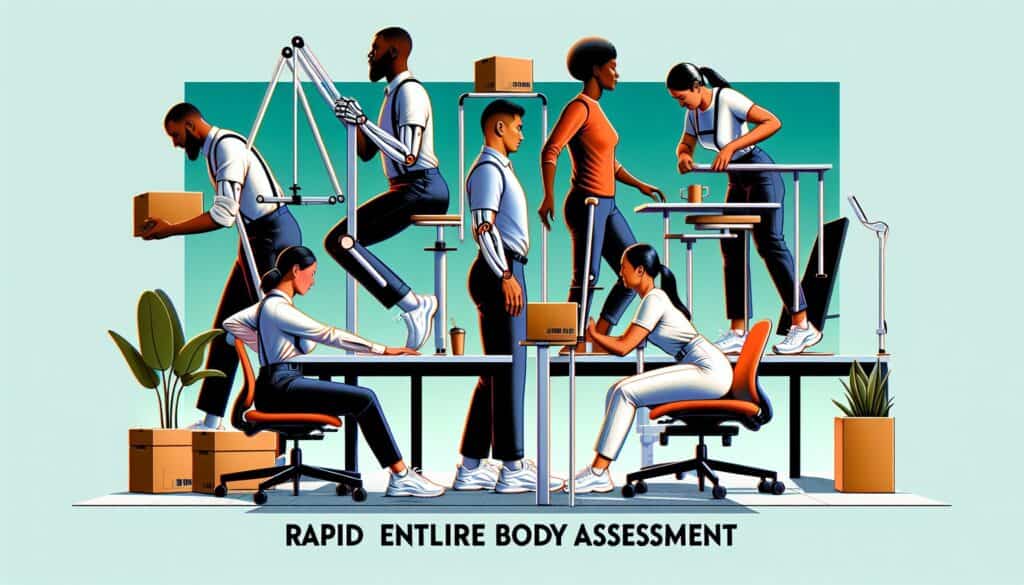أداة رصد تستخدم لتقييم المخاطر الوضعية للاضطرابات العضلية الهيكلية للجسم بأكمله المرتبطة بالعمل.
- المنهجيات: الهندسة, الجودة
التقييم السريع لكامل الجسم (REBA)

التقييم السريع لكامل الجسم (REBA)
- التحسين المستمر, بيئة العمل, العوامل البشرية, التصميم المرتكز على الإنسان, التصنيع اللين, تحسين العمليات, إدارة الجودة, إدارة المخاطر, أمان
الهدف:
كيفية استخدامه:
- يقيّم وضعيات الرقبة والجذع والساقين والذراعين، بالإضافة إلى الاقتران والحمل/القوة والنشاط. يتم إنشاء الدرجات للإشارة إلى مستوى خطر الإصابة باضطرابات التصلب المتعدد العضلي المتعدد والحاجة الملحة للتدخل.
الايجابيات
- يوفر تقييمًا شاملاً لمخاطر وضعية الجسم بالكامل؛ سريع الاستخدام نسبيًا؛ يساعد في تحديد أولويات الوظائف من أجل تحسينات مريحة.
سلبيات
- يمكن أن تكون غير موضوعية؛ تتطلب تدريبًا من أجل الحصول على درجات متناسقة؛ أداة فحص في المقام الأول، قد تحتاج إلى مزيد من التحليل لتصميم تدخل مفصل.
الفئات:
- بيئة العمل
الأفضل لـ
- تقييم المخاطر الوضعية للاضطرابات العضلية الهيكلية التي تؤثر على الجسم كله.
يمكن تطبيق منهجية التقييم السريع لكامل الجسم (REBA) في مختلف الصناعات بما في ذلك التصنيع والبناء والرعاية الصحية والخدمات اللوجستية، حيث يشارك الموظفون في كثير من الأحيان في مهام تتطلب حركة متكررة أو أوضاعاً محرجة مستمرة. يعتبر هذا التقييم ذا قيمة خاصة أثناء مرحلة تصميم مساحات العمل أو سير العمل، خاصة عند النظر في المتطلبات البدنية للعمال، مما يسمح للفرق بتقييم وإعادة تصميم تفاصيل المهام التي قد تؤدي إلى الإصابة. في سياقات الهندسة وتصميم المنتجات، غالبًا ما يشمل المشاركون أخصائيي هندسة بيئة العمل وأخصائيي الصحة والسلامة وقادة الفرق المسؤولين عن تحسين سير العمل. تسهل هذه المنهجية التقييم الموضوعي من خلال توليد درجات رقمية تصنف مستوى مخاطر الاضطراب العضلي الهيكلي (MSD) المرتبطة بأوضاع ومهام محددة، وبالتالي تحديد أولويات الوظائف للتدخلات المريحة. يشجع التطبيق السريع لهذا النظام على استخدامه في التقييمات الروتينية، مما يمكّن الشركات من مراقبة التغيرات في وضعيات وظروف العمل بانتظام، بهدف تقليل معدلات الإصابات وتحسين رفاهية العمال في نهاية المطاف. كما يمكن تنظيم دورات تدريبية لتثقيف الموظفين على جميع المستويات حول تقييمات ريبا REBA، مما ينمي الوعي بالمبادئ المريحة التي تعزز بيئة عمل أكثر أماناً. إن التطبيق المنتظم لهذه التقييمات لا يساعد فقط في الامتثال للمبادئ التوجيهية للصحة المهنية، بل يعزز الإنتاجية من خلال الحد من الإرهاق والتغيب عن العمل المرتبط بالإصابات المرضية متعددة الوظائف.
الخطوات الرئيسية لهذه المنهجية
- مراقبة وضعية العامل أثناء تنفيذ المهمة.
- قم بتقييم وضعية الرقبة والجذع والساقين والذراعين باستخدام معايير محددة مسبقاً لتسجيل النقاط.
- تقييم مستوى الاقتران بين أجزاء الجسم أثناء المهمة.
- تقييم أي حمل أو قوة تمارس على الجسم.
- ضع في اعتبارك النشاط المحدد الذي يتم القيام به ومتطلباته.
- احسب الدرجة الإجمالية بناءً على التقييمات الفردية.
- تحديد مستوى خطر الإصابة بالاضطرابات العضلية الهيكلية بناءً على الدرجة.
- تحديد أولويات الحاجة إلى التدخل بناءً على نتائج التقييم.
نصائح للمحترفين
- دمج نهج التقييم الديناميكي من خلال الجمع بين نتائج التقييم الديناميكي من خلال الجمع بين نتائج REBA ودراسة الحركة الزمنية لتعزيز فهم المهام المتكررة وتأثيرها على وضعية العامل.
- استخدام الأدوات الرقمية، مثل برنامج التقاط الحركة، لتكملة تحليل REBA من أجل تحديد أكثر دقة للمخاطر الوضعية وتطبيقات القوة.
- قم بتحديث معايير التقييم بانتظام استنادًا إلى الأبحاث المستجدة وأفضل الممارسات لضمان الملاءمة والدقة في تقييم بيئات العمل الحديثة.
لقراءة عدة منهجيات ومقارنتها, نوصي باستخدام
> مستودع المنهجيات الشامل <
مع أكثر من 400 منهجية أخرى.
نرحب بتعليقاتكم على هذه المنهجية أو المعلومات الإضافية على قسم التعليقات أدناه ↓، وكذلك أي أفكار أو روابط متعلقة بالهندسة.
السياق التاريخي
1986
(إذا كان التاريخ غير معروف أو غير ذي صلة، على سبيل المثال "ميكانيكا الموائع"، يتم تقديم تقدير تقريبي لظهوره الملحوظ)

منشورات ذات صلة
جدول الإنتاج الرئيسي (MPS)
التخصيص الشامل
قمع التسويق
التدقيق التسويقي
مؤشر MAPO (حركة ومساعدة مرضى المستشفيات)
تخطيط موارد التصنيع (MRP II)